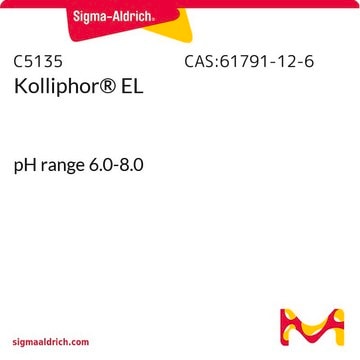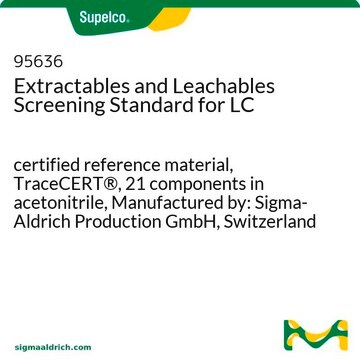If this product has an expiration or retest date, it will be shown on the Certificate of Analysis (COA, CofA). If there is no retest or expiration date listed on the product's COA, we do not have suitable stability data to determine a shelf life. For these products, the only date on the COA will be the release date; a retest, expiration, or use-by-date will not be displayed.
For all products, we recommend handling per defined conditions as printed in our product literature and website product descriptions. We recommend that products should be routinely inspected by customers to ensure they perform as expected.
For products without retest or expiration dates, our standard warranty of 1 year from the date of shipment is applicable.
For more information, please refer to the Product Dating Information document: https://www.sigmaaldrich.com/deepweb/assets/sigmaaldrich/marketing/global/documents/449/386/product-dating-information-mk.pdf
Wichtige Dokumente
57668
D-α-Tocopherol-Polyethylenglycol-1000-Succinat
BioXtra, water soluble vitamin E conjugate
Synonym(e):
D-α-Tocopherol-Polyethylenglycolsuccinat, TPGS, Vitamin E-TPGS, Vitamin-E-Polyethylenglycolsuccinat
Größe auswählen
About This Item
Empfohlene Produkte
Biologische Quelle
synthetic
Produktlinie
BioXtra
Form
powder, crystals or chunks
Zusammensetzung
α-tocopherol, ≥25%
Konzentration
≥25% (ALPHA TOCOPHEROL)
Farbe
white to light brown
mp (Schmelzpunkt)
>36 °C
Löslichkeit
H2O: 1 g/10 mL, clear to faintly turbid, colorless to faintly yellow
Kationenspuren
Al: ≤5 mg/kg
Ba: ≤5 mg/kg
Bi: ≤5 mg/kg
Ca: ≤5 mg/kg
Cd: ≤5 mg/kg
Co: ≤5 mg/kg
Cr: ≤5 mg/kg
Cu: ≤5 mg/kg
Fe: ≤5 mg/kg
K: ≤50 mg/kg
Li: ≤5 mg/kg
Mg: ≤5 mg/kg
Mn: ≤5 mg/kg
Mo: ≤5 mg/kg
Na: ≤50 mg/kg
Ni: ≤5 mg/kg
Pb: ≤5 mg/kg
Sr: ≤5 mg/kg
Zn: ≤5 mg/kg
Lagertemp.
2-8°C
SMILES String
CC1=C(C(=C(C2=C1OC(CC2)(C)CCCC(C)CCCC(C)CCCC(C)C)C)OC(=O)CCC(=O)OCCO)C
InChI
1S/C35H58O6/c1-24(2)12-9-13-25(3)14-10-15-26(4)16-11-20-35(8)21-19-30-29(7)33(27(5)28(6)34(30)41-35)40-32(38)18-17-31(37)39-23-22-36/h24-26,36H,9-23H2,1-8H3
InChIKey
AOBORMOPSGHCAX-UHFFFAOYSA-N
Suchen Sie nach ähnlichen Produkten? Aufrufen Leitfaden zum Produktvergleich
Allgemeine Beschreibung
Darüber hinaus wirkt Tocofersolan als Inhibitor der durch das Substrat P-Glycoprotein (P-gp oder MDR1) induzierten ATPase-Aktivität in zellfreien Assays. Es hat erwiesene Wirksamkeit gegen resistente K562-Zellen durch die Bindung an den Plasminogenaktivator vom Urokinase-Typ, einem wichtigen Enzym für die Migration und Invasion von Krebszellen. Darüber hinaus hemmt Tocofersolan die Tyrosinkinase, ein wichtiges Enzym bei der Entstehung von Krebszellen, und findet potenzielle Anwendung in der Metabolomik und biochemischen Forschung. Seine Fähigkeit, die Resorption wasserunlöslicher Stoffe und anderer fettlöslicher Vitamine zu verbessern, macht es zu einer vielversprechenden Verbindung für die Forschung zu Darreichungsformen und zur Abgabe von Arzneistoffen.
Anwendung
Biochem./physiol. Wirkung
Tocopherol-Polyethylenglycol 1000-Succinat (TPGS) kann zur Herstellung biologisch abbaubarer Polymere und antioxidativer Tenside verwendet werden.
TPGS weist Anti-Tumor-Aktivität auf MCF-7- und Brustkrebszellen aus, indem es Apoptose-hemmende Proteine herunterreguliert.[2]
TPGS findet Anwendung als Emulgator bei der Herstellung von PLGA-Partikeln (Poly(Milchsäure-Co-Glycolsäure)) zur DNA-Markierung, bildet Partikel von einheitlicher Größe, zeichnet sich durch Einkapselungseffizienz aus, erhöht die Hydrophilie und verhindert die Aggregation von Partikeln.[1]
Leistungsmerkmale und Vorteile
- Kann in der Metabolomik- und biochemischen Forschung verwendet werden
- Hochwertige Verbindung, geeignet für zahlreiche Forschungsanwendungen
Sonstige Hinweise
Lagerklassenschlüssel
11 - Combustible Solids
WGK
WGK 2
Flammpunkt (°F)
>392.0 °F
Flammpunkt (°C)
> 200 °C
Persönliche Schutzausrüstung
Eyeshields, Gloves, type N95 (US)
Hier finden Sie alle aktuellen Versionen:
Besitzen Sie dieses Produkt bereits?
In der Dokumentenbibliothek finden Sie die Dokumentation zu den Produkten, die Sie kürzlich erworben haben.
Kunden haben sich ebenfalls angesehen
-
How can I determine the shelf life / expiration / retest date of this product?
1 answer-
Helpful?
-
-
How is shipping temperature determined? And how is it related to the product storage temperature?
1 answer-
Products may be shipped at a different temperature than the recommended long-term storage temperature. If the product quality is sensitive to short-term exposure to conditions other than the recommended long-term storage, it will be shipped on wet or dry-ice. If the product quality is NOT affected by short-term exposure to conditions other than the recommended long-term storage, it will be shipped at ambient temperature. As shipping routes are configured for minimum transit times, shipping at ambient temperature helps control shipping costs for our customers. For more information, please refer to the Storage and Transport Conditions document: https://www.sigmaaldrich.com/deepweb/assets/sigmaaldrich/marketing/global/documents/316/622/storage-transport-conditions-mk.pdf
Helpful?
-
-
what is the molecular formula of this product
1 answer-
The exact molecular weight of the product is not determined. The number in the description of the product "1000" refers to the approximate molecular weight of the PEG tail. The molecular weight of D-α-Tocopherol succinate is 530.78.
Helpful?
-
-
Hello, I would like to know how to correctly handle this product: is it required (due to possible inhomogeneity) to melt the entire bottle before dispensing or it is not the case? also, how many melting cycles are safe to be performed?
1 answer-
This product is listed as a waxy solid. Most lots are released as chunks which can be weighed up without melting. However, if small, precise amounts are required, melting to liquify is suitable. The Tocopherol in this complex is esterified and quite stable, however it may be best to aliquot working volumes to minimize reheating. The density at 45 °C is 1.06 g/mL. See the image below to review published information on the thermal stability with repeated heat cycles.
Helpful?
-
Active Filters
Unser Team von Wissenschaftlern verfügt über Erfahrung in allen Forschungsbereichen einschließlich Life Science, Materialwissenschaften, chemischer Synthese, Chromatographie, Analytik und vielen mehr..
Setzen Sie sich mit dem technischen Dienst in Verbindung.












